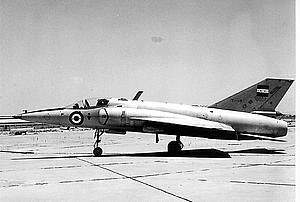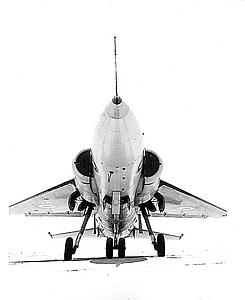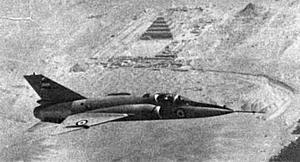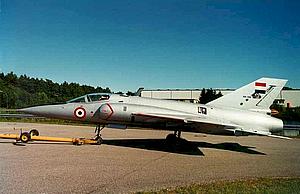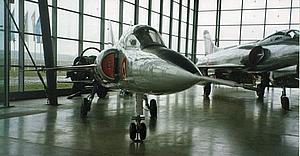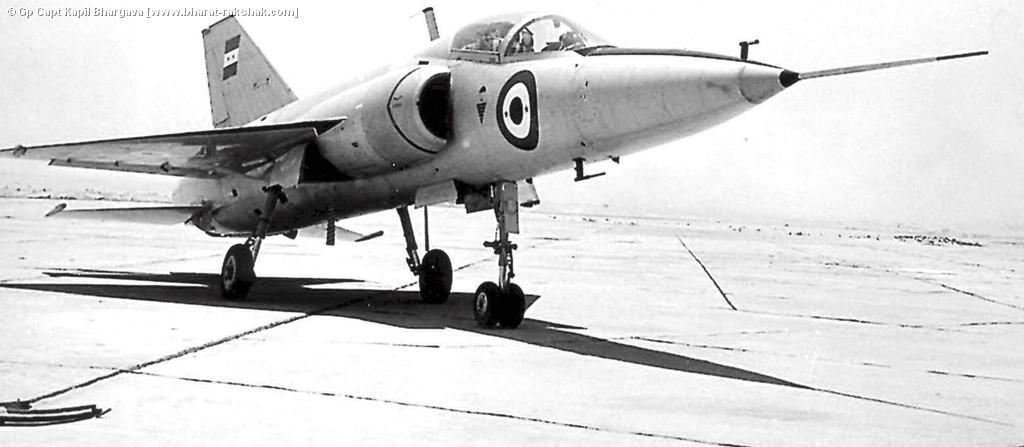
|
| The Helwan HA300 fighter prototype was originally a project by Hispano Aviacion in Spain before it was acquired by Egypt. |
Prof Willy Messerschmitt
Professor Willy Messerschmitt was almost certainly the world’s finest aircraft “constructor”. Before World War II began, he had manufactured more than 35,000 Me-109s at the rate of more than one each day. This many fighter aircraft of one type had never been made before nor will ever be seen in future.
After WW II, all German designers and technologists were prohibited by the Allies to undertake any research for defence purposes. Prof. Messerschmitt was even limited on his movements within Germany. He set up a new firm Hispano Aviacion in Spain and started designing an ultra-light fighter aircraft in 1951. Only a delta shaped plywood glider without a tail was built. Its first flight, being towed by a CASA C- 2.111 (the Spanish Heinkel He-111), was abandoned due to instability before getting fully airborne. Eventually the Egyptians took over the HA-300 project. A German design team moved to Helwan, south of Cairo. The shift of the project from Spain to Egypt resulted in the letters HA (originally Hispano Aviacion) referring to Helwan Aircraft, at least as far as the Egyptians were concerned. The HA-300 was a most ambitious development project. It was an ultra-light single seat delta shaped fighter aircraft with a separate tail plane. It was Professor Willy Messerschmitt’s last design and the only truly supersonic one. He was already famous for Me-109 and Me-262, etc.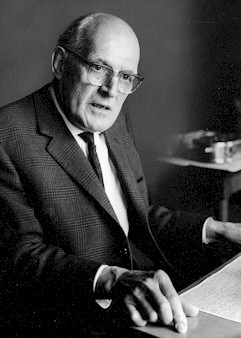
The HA-300 was the smallest jet fighter aircraft ever designed and flown. Even the Gnat was bigger than it. Its delta wing was swept at 57.5° and its thickness/chord ratio was just 3%. Prof. Messerschmitt was well ahead of his time in the concept of his first supersonic design. Unfortunately, he did not have an adequate industrial base from which to launch this daring design. If he could have done this work in a developed country, the HA-300 may well have been a success.
The wing design of HA-300 was also revolutionary. Its thickness to chord ratio was only 3%. This is still the thinnest duralumin aerofoil ever to be flown. Clearly, the HA-300 would have had amazing performance due to its lightness and very high thrust/weight ratio. These would have allowed it to go up almost vertically and reach 12,000 metres in only 2.5 minutes from brakes off. But, the thinness of its wing also meant that flutter was very likely. Its very small wingspan of just 5.84 metres meant that damping in roll at high altitude would have been low. This could result in inertia coupling at high rates of roll. The rudder was quite high above the centre line. The HA-300 was never tested for inertia coupling. But, it did show slight adverse bank on use of rudder.
The Indian Connection
The Indian participation in Egypt’s aircraft industry was the direct result of a close understanding between Pandit Nehru and President Gamal Abdul Nasser. Suffice it to say that I was deputed by the Indian Air Force to work as a test pilot in the Egyptian Aircraft Factory 36 at Helwan. The Egyptians had no qualified test pilots, and the project needed one. The German experts at Helwan had wanted a European test pilot, but none was available. When I arrived at Helwan in June 1963. I was escorted to Fritz Schaeffer who was the former test pilot of Heinkel and had flown the world’s first jet fighter in 1941. As in-charge of the flight test group, he bluntly told me that I was not wanted and should not dream of flying the HA-300. I could keep myself amused with the HA-200 (Saeta) twin engine basic trainer aircraft, Messerschmitt’s last but one design, being produced under license at Helwan. Air Marshal M Sidky Mahmoud, Commander Egyptian Air Force (CAS), expressed his inability to force the Germans to use my services.
I pointed out that if the Egyptians had no use for me, I would prefer to return to India, as test pilots were not exactly in surplus there. The Air Marshal then suggested that, although I would normally be engaged in the production testing of the HA-200, I should simultaneously “keep an eye on the HA-300”. The situation changed somewhat dramatically a few days later, however, when it was decided that the HA-300 would be taxied in front of President Gamal Abdul Nasser during the Egyptian Republic Day celebrations of July 1963. Since no other test pilot was available, the German staff conceded that I might be permitted to taxi their prototype fighter. In their opinion, I was unlikely to do much harm merely taxying the aircraft!
The performance of this “simple exercise” proved rather more complex than had been anticipated owing to a number of factors. The damping of the nose oleo leg was unsatisfactory and resulted in the aircraft pitching violently on encountering the slightest roughness in the runway surface. The self-centring action of the nose wheel was so powerful that the wheel tended to skid and jump sideways rather than turn. Tremendous effort was put into reaching a reasonably acceptable compromise between nose wheel shimmying and turning stiffness, and it was thus possible to demonstrate gentle taxying of the aircraft in front of the President.
This occasion was the only time that I met President Nasser in person. He was accompanied by Mr Anwar El Sadat, who later succeeded him as President. I explained to President Nasser the layout and the most interesting features of the HA-300 and was asked my personal opinion of the Helwan fighter. In my reply, I endeavoured to imply that left to the foreign staff alone, the HA-300 would make an interesting research project but would never be developed into an effective weapon system. He just smiled. I concluded that, despite any difficulties that might hinder the project, he had his reasons for persisting with it and that too under the control of foreigners. He obviously believed that a successful flight test would be sufficient to strengthen his hand in international negotiations.
When the Germans failed to hire any European test pilot, in October 1963, I was asked by the Egyptian Air Chief to do its maiden flight. I told him that the aircraft was a death trap and I was not willing to fly it. The next few messages between Prof. Messerschmitt and me were relayed by the Air Chief to each of us. On being told of my fears, Prof. Messerschmitt said that he had not wanted “a bloody Indian pilot”, as he was sure to be chicken. My response was that I was not just chicken – I was s…t scared. I said I would be very dead, if I tried to fly the aircraft until its deficiencies were removed. To settle the dispute we invited Wing Commander Suranjan Das from HAL to give his opinion on the aircraft’s hazardous design features. He took my list of dangerous features and completely confirmed my views. He sent six copies of my report with a covering letter informing all concerned authorities that no Indian test pilot should be permitted to fly the aircraft till its shortcomings were eliminated. I thus became the only pilot available for the HA-300 V-1’s first flight.
My most memorable encounter with Prof. Messerschmitt soon followed this conclusion. One day I was told that the Professor wanted me in his conference room. On entering it, I saw that it was laid out like a kangaroo court. At the head of some long tables was Prof. Messerschmitt with an interpreter beside him. Senior Germans were seated on one side, with their Egyptian counterparts opposite them. The bottom end had one seat for me, the accused. Prof. Messerschmitt asked me through his interpreter why I was so insistent on the modifications, which I had claimed were essential to ensure safety. By then I was quite angry and replied that I was not really interested in the mods. They were my conditions to fly the aircraft. Otherwise, another test pilot could be hired and I would happily go back home to India.
There were many German red faces on hearing this answer. The word ultimatum buzzed around between them. People did not issue an ultimatum to Prof. Messerschmitt. However, he calmed his team down and told me that while he might agree to make the changes, he wanted to know why I was so adamant to have them done. Still boiling mad, I said that a technical lecture was necessary and I would proceed to give it if he really wanted it. He quietly agreed to listen.
I reminded Prof. Messerschmitt that the contract for the aircraft specified the design to conform to the British Air Publication-970 requirements, which laid down the design criteria for military aircraft. The nineteen points listed by me were all in serious breach of the AP. A few of them were so obvious that it was a wonder that the design team did not anticipate them. For example, the integral fuel tanks had leaked and flexible rubber tanks were inserted in them. Some of these had also leaked. Yet, the only indication for fuel contents was a totaliser gauge showing the fuel entering the engine. The pilot would know that all fuel had leaked out only after his engine cut. The fuel system had apparently been designed with a preoccupation for unlimited inverted flying. Firstly, there was no requirement for such a facility and, secondly, the Orpheus engine’s oil system would, in any case, have limited the maximum duration of inverted flight to about 10 seconds. The direct supply tank to the engine was the smallest in the system and any failure of air transfer pressure would produce a flameout within two minutes. The tail plane trim was operated by a single-pole switch on the stick carrying the entire current of the large motor, without any protection against a trim run away. Rudder flutter was forecast at 0.56 M. Yet, its damper was powered by a single hydraulic system. Other design deficiencies, too many to list here, were also dangerous and unacceptable to me as a qualified test pilot.
Prof. Messerschmitt did not take long to realise that I was right in my concern for the aircraft’s safety. It takes a really great man to admit that he is wrong. The Professor got up from his chair and shook my hand. He said that he had not realised how far his team had fallen back in design expertise. He assured me that all required actions would be taken and he would instruct his staff to follow my directions. It took just six months after this meeting for me to declare the aircraft ready for flight.
The first flight
The first flight on March 7, 1964 was as much routine as the maiden flight of a fighter aircraft of a revolutionary design can ever be. There was no trouble of any kind in its short duration of 12½ minutes. The excitement came after the flight. When we were sipping champagne, Prof. Messerschmitt shook my hand and held it for a while. He was trembling. I asked him what the matter was and why he was so tense. He replied, “When I think of what could have happened”. I told him that we had done all our worrying on the ground with every contingency planned for. The safety of the aircraft was the issue with which we had been struggling for six months. He said that while that was all very well, many of his prototypes had crashed on the first or an early flight. I lightly replied that he should have listened more to his test pilots and not threatened to send them off to the Russian Front if they disagreed with him. He just smiled.
Our safety precautions allowed the two prototype aircraft (V-1 and V-2) to complete 135 flights without a single accident. The aircraft was very pleasant to fly – for me. Its control forces had been adjusted to meet my requests. The aircraft’s response in rates of roll and stick force per G was exactly as I liked. I was able to take the V-2 (Second Prototype) to 1.13 M. During flutter testing Major Sobhy El Tawil trained by me as a test pilot encountered flutter when a thruster on the left wing was fired. He followed the briefing exactly and did not allow aerodynamic loads to increase. Instead, he throttled back and gently eased out of the dive. He returned safely with a cracked inner hinge of the left flap-cum-aileron. The German staff was very impressed with his airmanship. This was the only safety hazard seen on the aircraft during its entire history. The HA-300’s maximum speed and ceiling were limited as all flying was done with the Orpheus 703 engine.
The foreign technical staff working on the HA-300 airframe and the E-300 engine wholeheartedly embraced proposals for collaboration with India in the venture. The principal motive of the Egyptians was presumably to get India to share the cost of developing the E-300 engine, which was offered as an option for India’s own HF-24 Marut. For Dipl Ing Brandner and his team, Indian collaboration provided the opportunity to flight test the engine in a really suitable airframe. Four prototype E-300 engines had each completed 2,000 hours static running in test cells before the ninth prototype engine had begun flight trials beneath the wing of an An-12. This installation was proving somewhat less than satisfactory owing to the limited flight envelope possible.
India had built an HF-24 with reheated Orpheus engines and for this development HAL had enlarged the rear end of the aircraft. Consequently, it was a relatively simple job to adapt an HF-24 airframe powered by a pair of normal Orpheus engines but easily modified to replace one or both with E-300s. This aircraft, referred to as the IBX, was flight tested in India with normal Orpheus engines and again in Egypt after delivery and reassembly at Helwan. Shortly thereafter, an E-300 was installed in the starboard engine bay. A team from HAL supported the flight testing of this aircraft, despite the technical and logistical difficulties resulting from the distance between Bangalore and Helwan, well over a hundred flights being performed and the E-300 being declared ready for installation in the single-engine aircraft – the HA-300.
Apart from just over a dozen flights performed by me, all flight testing of the IBX was undertaken by Wg Cdr IM Chopra who later became Chief Test Pilot at Bangalore and finally retired as Chairman of HAL. The contribution to the development of the E-300 engine made by him and Gp Capt (later Air Marshal) CS Naik, a Cranfield graduate, was invaluable, especially since few of the local technical staff possessed much knowledge or experience of flight testing and analytical techniques.
Prof. Messerschmitt asked Prof. KW Tank, who had just finished his assignment with HAL, to stay in Helwan to help complete the development of the HA-300. Indian policy makers, including the CAS, were quite confused about collaboration with Egypt. According to them both countries would use the HF-24 fitted with the E-300 engine. The Indian authorities had not realised that the Egyptians were not interested in the HF-24. When this became clear, official Indian enthusiasm for the E-300 also disappeared. This was the death knell of the HA-300 project. Foreign experts working at Helwan began to drift away. The Egyptians also ran out of patience and money, and closed the project in May 1969. My attempts to fly the V-3 with the E-300 engine, designed specifically for the HA-300, did not succeed due to problems with the engine.
Prof. Messerschmitt and I parted as good friends and with high regard for each other. He along with Prof. Tank paid me a high compliment by asking me to join the Panavia flight test management group. This was obviously not possible for me, as I was still a serving Indian Air Force officer. The first flight of the HA-300 was the highlight of my sixteen-year long test-flying career.
The Restoration
In 1991, Daimler-Benz Aerospace AG (DASA) bought up the H-300 V-1 and airlifted it to Germany. Apprentices of MBB at Manching under proper supervision worked for five and a half years to restore it for exhibition at the Deutsches Museum.
My article on the HA-300 published in 1980 in a UK aviation magazine enabled DASA and the Messerschmitt Stiftung (Foundation) to trace me in Bangalore. The Foundation then invited me to attend a ceremony on 26th March 1997 for DASA to hand over the aircraft to the Deutsches Museum. It was very well attended, with more than 300 guests including all the top hierarchy of aviation of Munich, Manching and environs. Many relatives of Prof. Messerschmitt were invited for the occasion. Two or three engineers who had worked in Helwan on the E-300 engine were also present. I was also asked by the Messerschmitt Stiftung to deliver a talk on my experience of flying the HA-300.
Mr Aloysius Rauen, Senior Vice President of the Military Aircraft Division of DASA, described the problems faced by German designers immediately after Word War II, including restrictions on the movements of Prof. Messerschmitt even in Germany. These lasted till 1948. He then traced the history of Prof. Messerschmitt’s work in Spain from 1951 till the definition of the HA-300 to its final form. He concluded that due to various constraints, the HA-300 could not be produced as a fighter but its concept led to the emergence of the MiG-21 in USSR.
Professor Gero Madelung, who had worked with Prof. Messerschmitt in Spain, followed Mr Rauen. He showed the various aerodynamic designs and features considered for the HA-300 and how its final form had emerged. Mr W.L. Blasel, General Manager (Light Aircraft) at Flugzeug-Union Sud, described how he had negotiated with the Egyptians and brought the aircraft to Germany. Then, DASA’s apprentices from Manching presented a record of their work on restoration of the aircraft. When they had received it, it was full of sand, bird nests and corrosion. After they finished with it, the aircraft looked better than it did for its first flight. It had taken them 20,000 hours of hard work to get the aircraft fit for the Museum to their satisfaction! The cockpit had been restored as far as possible and looked quite familiar to me.
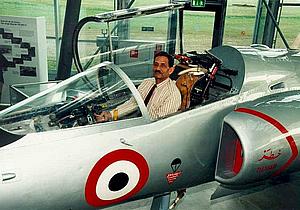
|
The Author, Gp Capt Kapil Bhargava (Retd) in the cockpit of the HA-300 at the handing over of the restored HA-300 to the Deutsches Museum. |
| Another view of the event. | 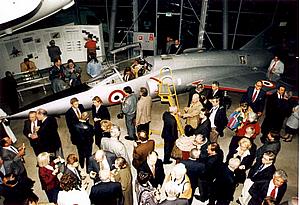
|
After these speakers, I spoke of my impressions of the project. Most of my speech is included in this article above. I also pointed out that I had the privilege of having flown the very last Messerschmitt design and his first supersonic aircraft. At the end of my talk, a short extract was played from my recording made in the Air Traffic Control of Helwan during the first flight of the HA-300. This gave a very good feel of the excitement of the safe landing of prototype HA-300 V-1 and was well received by the audience. I sat in the V-1 cockpit for a long time after my talk. This enabled interested persons to photograph me and to ask me technical and other questions about the HA-300. I was surprised by the number of people who asked for my autograph on the programme brochure of the ceremony.
Now the HA-300 is in Munich’s Deutsches Museum at Schleissheim just north of Munich. Hopefully visitors will look at the HA-300 and be deeply impressed that there was real genius behind its concept. By coincidence, or by design, the aircraft just behind the HA-300 was the HF-24 Marut, as the last project of Prof. Kurt Tank, taken from HAL Bangalore to the Deutsches Museum.
Even though my long stint in Egypt jeopardised my career opportunities in the IAF, I never regretted being deputed for this job. I shall forever cherish the memory of having handled the last design of an exceptional aeronautical designer and manufacturer and having earned due recognition from him. Prof. Messerschmitt’s one-hundredth birth anniversary was observed by DASA and the Foundation on 28th June 1998 with justifiable pride and nostalgia. A special hall at the Deutsches Museum now holds his famous aircraft types with other information to inspire visitors to follow his exceptional example in development of aeronautical art and science
Copyright © Gp Capt Kapil Bhargava (Retd) . All rights reserved. Reproduction in whole or in part in any form or medium without express written permission of Gp Capt Kapil Bhargava (Retd) is prohibited.
